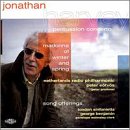| All Artists: Jonathan Harvey, Peter Eötvös, George Benjamin, Netherlands Radio Philharmonic Orchestra, London Sinfonietta, Penelope Walmsley-Clark Title: Jonathan Harvey: Song Offerings; Madonna of Winter and Spring Members Wishing: 0 Total Copies: 0 Label: Nimbus Records Release Date: 8/15/2000 Genres: Pop, Classical Styles: Vocal Pop, Opera & Classical Vocal, Forms & Genres, Concertos, Symphonies Number of Discs: 1 SwapaCD Credits: 1 UPC: 710357564925 |
Search - Jonathan Harvey, Peter Eötvös, George Benjamin :: Jonathan Harvey: Song Offerings; Madonna of Winter and Spring
 | Jonathan Harvey, Peter Eötvös, George Benjamin Jonathan Harvey: Song Offerings; Madonna of Winter and Spring Genres: Pop, Classical
|
Larger Image |
CD Details |
CD ReviewsSomewhat disappointing, Harvey should write through-composed scarecrow | Chicago, Illinois United States | 10/10/2000 (4 out of 5 stars) "Madonna of Winter and Spring was composed in honour of Mary,mother of Jesus. The piece the jacket notes inform portrays the action of her soft,yielding influence of forces which are assertive,brutal and despondent,but her "touch" is felt from time to time. Such deep liturgical associations is a rarity now,Harvey seems deeply committed to the spirit world,of images from Catholicism,his music predictably enough does resemble Messiaen,with its brilliant sense of orchestration, the stop=go gestures, the complex webs of wind filigree moments,the metal bell timbres,are all DNA residues of both creators. Conflict,is very similar to much of what I've heard emanating from IRCAM, Eotvos, Dufourt, Grisey, Murail, and Boulez which I suspect is the hidden fountain,a musical resevoir. The first movment here Conflict has this stop,go action,deeply angular,thorny,brutal at times not until we get to Descent,does the real Harvey reveal himself. There we find a continuously sustained sonority deeply attenuated, shaped, allowing the density to disperse,to calm itself to accelerate,to glow and spin. He is brilliant in his mixtures,joining the acoustic world with electronic sounds,an aspect of contemnporary expression which no one ever resolved with any degree of conviction. The electronics here deeply mate with the acoustic world and the winds cohere to it,like a glowing magnetic web of sound,somewhat cold,swirling,again the timbral association as a staple product of IRCAM is unmistakable. Well Harvey worked in this underground mecca for new music creation in Paris throughout the Eighties.Peter Eotvos with the Netherlands Radio Philharmonic play seemlessly,Eotvos has admirably mounted Boulez's revered place as reader/conductor of this music. He has the vision and sensitivity to the timbral transformations. The percussion concerto has fascinating features as well,the marimba seems to be the dominant solo voice here,well suited and the marimba is constituted with a large pallette of sound and diversity,even though its timbre is one-dimensional,but I had wished Harvey would structure his creations around through-composed works, the movement divisions I found don't really help the listener decipher his aesthetic strategy. Harvey's timbral imagination seems to fly away into heightened states when he doesn't divide and break his music. Here I thought this concerto would have been all the more powerful without divisions. Harvey's music doesn't have large contrast,to distimguish itself from movement to movement. The movements cannot be defined as self-contained,at least from the listener's perspective. The Songs Offerings did do that,,self-contained discreet songs,yet there remained a timbral similarity between the four songs here admirably delivered by Penelope Walmsley-clark,soprano who is well versed in this music.The timbres here are gorgeous percussion,piano bells,fast mists of sound which do not disrupt the vocalist.The text is delivered in a kind of sing song way,phrases which Sir Edward Elgar could have written.There wasn't a free sense of the voice as a temptress inhabiting itself over the beautiful timbral fields. In the songs we have now the London Sinfonietta under the direction of composer George Benjamin,who knows Harvey's music quite well."
|

 Track Listings (11) - Disc #1
Track Listings (11) - Disc #1